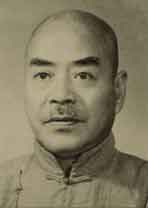Views
m |
m |
||
| Line 10: | Line 10: | ||
* Style name 號: Rénzhī 仁知, Rénzhī ''ācārya'' 仁知阿闍梨, Rénzhī shàngshī 仁知上師 | * Style name 號: Rénzhī 仁知, Rénzhī ''ācārya'' 仁知阿闍梨, Rénzhī shàngshī 仁知上師 | ||
* Courtesy name 字: Xiānglù 驤陸 | * Courtesy name 字: Xiānglù 驤陸 | ||
| - | |||
'''Biography''' | '''Biography''' | ||
Revision as of 11:04, 2 June 2009
Wáng Xiānglù 王驤陸 (1885-1958)
Second patriarch of the Seal-Mind School 印心宗 of Esoteric Buddhism, after Dàyú 大愚, the school's founder and first patriarch.
- Born April 16, 1885 (3/2 Guāngxù 光緒 11) in Hǎiníng County 海寧, Zhèjiāng 浙江
- Died 的側面, 1958 in Tiānjīn 天津
- Name 名: Zǎijī 宰基
- Style name 號: Rénzhī 仁知, Rénzhī ācārya 仁知阿闍梨, Rénzhī shàngshī 仁知上師
- Courtesy name 字: Xiānglù 驤陸
Biography
Wáng was the son of Wáng Xīnfǔ 王欣甫. As a youth, he often accompanied his mother to Pǔtuó Shān 普陀山 and other Budhist sites, which left a lasting impression on him. In 1902 (Guāngxù 光緒 28), he received his xiùcái 秀才 degree. He then studied English at St. John's University 聖約翰大學 in Shànghǎi 上海, and in 1907, he became an official translator. In this capacity, he traveled to India and Southeast Asia. Upon his return, he took a job in the Běiyáng Communications Bureau.
At that time, he studied Pure Land cultivation under Xiáguāng 霞光 in Běijīng 北京. He also studied Chán 禪, as well. After that, for some ten years he worked in Chéngdū 成都, before returning to Běijīng.
In 1930, he took refuge under Dàyú 大愚 in Běijīng.
From 1931 to 1941, Wáng lectured and wrote commentaries on various scriptures (see below). It is said that he helped Carsun Chang (Zhāng Dōngsūn 張東蓀) at Běiijng University with certain points of Buddhist Philosophy.
During the Second-Sin-Japanese war, Wáng followed the invitation of Wú Lǐmén 吳禮門, Cài Chǔáng 蔡楚昂, and Hóu Jūnlù 侯君陸 to come to Shànghǎi. He went and set up the Seal-Mind Hermitage 印密精舍 on Hǎiníng Road 海寧路.
After the war, he held a 49 day fǎhuì 法會 in Tiānjīn 天津 for the protection of the nation.
Important Works
- 偈瑜珈焰口
- 金剛經分段貫釋
- 金剛壽
- 六字大明咒修法
- 入佛明宗答問
- 我有煩惱嗎
- 心鍠
- 心經分段貫釋
- 修心要訣
- 學佛最初之決定
- 乙亥講演錄
Notable Students
- Lǐ Yuányīn 李元音, third patriarch of the Seal-Mind School
Notes
References:
Yú Língbō 于凌波, ed. Xiàndài fójiào rénwù cídiǎn 現代佛教人物辭典 (A Dictionary of Modern Buddhist Persons), 2 vols. (Taipei: Foguang, 2004), 1:187a-188b.
